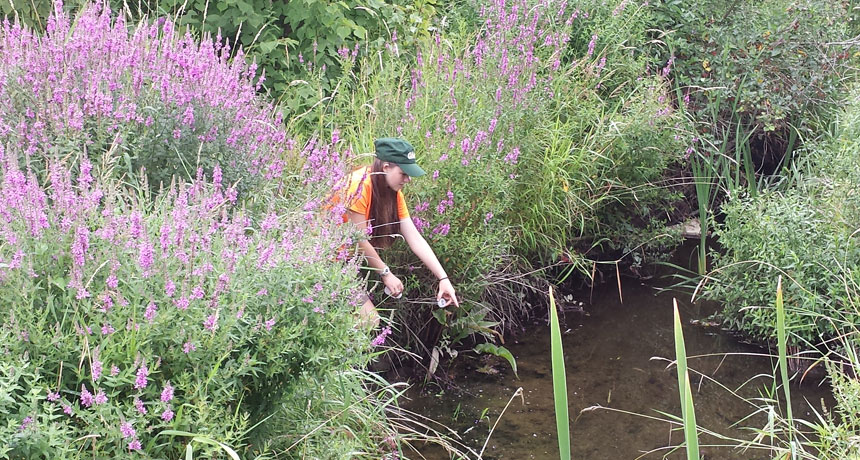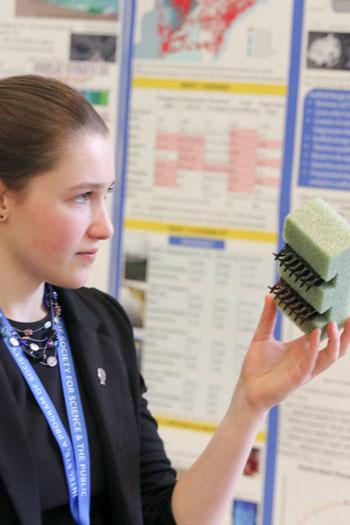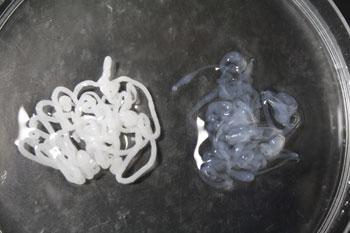Regeneron STS, Young & Amazing
This teen designed a filter to save a stream

As a kid, Paige Brown, 17, spent time playing in and around the local streams of Bangor, Maine. She thought they must be pretty clean. After all, she played in them and didn’t get sick. But an experiment in science class at Bangor High School showed that the water might not be as pristine as she had thought. That led Paige to study the streams — and design a filter to remove a serious pollutant in them.
The project impressed a number of people. Paige’s work earned her a first place prize of $150,000 in Washington, D.C. on March 15 at the Intel Science Talent Search. The competition brings together 40 high school seniors each year to share their projects with the public and compete for awards. (This year, the total exceeded $1 million.)
Be a champion for strong science. Join the Society now.

Two years ago, Paige took Advanced Placement chemistry. Her class performed an experiment to measure dissolved phosphorus in water. As part of the testing, students were asked to bring in samples of water. Paige collected a vial from a local stream. When she tested it, she says, “I was blown away.” It had extremely high levels of phosphorus.
This element is an important plant nutrient. When soils do not contain enough of it for crops to thrive, farmers and gardeners may add it as a form of fertilizer. Not all of the fertilizer ends up in the plants, however. Some washes off of the soil during rains. Then it can flow into nearby streams, giving algae and aquatic plants a sudden nutrient buffet. The aquatic greenery will respond by growing explosively.
The high levels of phosphorus in Paige’s local stream worried her.
Later, though, those greens will die. And their decaying remains will fuel the growth of bacteria. As they chow down, those bacteria will use up much of the oxygen in the water. Without that oxygen, fish and other creatures can suffocate. This whole process — from loads of nutrients to water empty of oxygen — is called eutrophication.
The high levels of phosphorus in Paige’s local stream worried her. She wondered what else might be lurking in the nearby waters. To find out, she began working with researchers at the University of Maine in Orono. Their Storm water Management Research Team helps local students get involved in studying water quality.
Paige monitored seven local streams in Bangor over a period of nine months. She measured phosphorus, the stream’s pH — or acidity — and how much oxygen was dissolved in their waters. She also collected bacteria from these streams and then grew colonies of them in her high school lab.
She found that phosphorus levels rendered five of her streams “impaired,” according to standards set by the Maine Environmental Protection Agency. This meant their phosphorus levels were too high — putting them at risk of eutrophication.
All seven of the streams Paige studied also had high levels of the bacteria E. coli. When she counted the bacteria, the level in one stream “was off the charts.” she says. High levels of this germ can indicate that the water is dangerous to swim or play in.
Phosphorus and E. coli levels both spiked after rains, Paige found. Streams that were surrounded by buildings and parking lots were affected most. These are places where rain runs directly into the water instead of through a filter of vegetation.

Paige decided to try to remove the extra phosphorus that was building up in the water after storms. To do this, she designed a filter, each about the size of a quarter. She started with calcium alginate, a molecule usually found in seaweed, which forms a gel. In it, Paige embedded magnesium and aluminum. These metals bind phosphorus when it bumps into them. The new chemical that forms then precipitates out of the water — becoming a solid that can be removed easily.
“They’re tiny but mighty,” Paige says of her filters. “Each absorbs 127 milligrams [0.0044 ounce] of phosphorus.”
She made a housing for her filters out of a foam block and two hair clips. And she wrapped the package with a bit of T-shirt to keep hungry fish at bay. The whole apparatus costs around $3.
“They’re tiny but mighty,” Paige says of her filters.
Paige eventually plans to place the filters in detention ponds, holding ponds constructed to collect storm water so that it doesn’t flood the surrounding area. After rains, runoff can sit for a short time before being carefully released into a natural stream or lake. By adding her filters to these ponds, Paige hopes to catch the phosphorus before it can pollute local streams.
And she isn’t done. Now that she’s got a filter that removes phosphorus, Paige wants to improve it by adding silver nanoparticles. Such tiny silver bits can kill bacteria, such as those E. coli. By reducing the extra nutrients and bacteria in local streams, Paige hopes to end up with water that is as clean as it looks.


